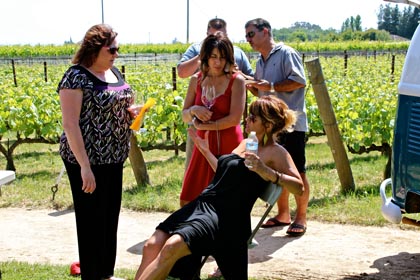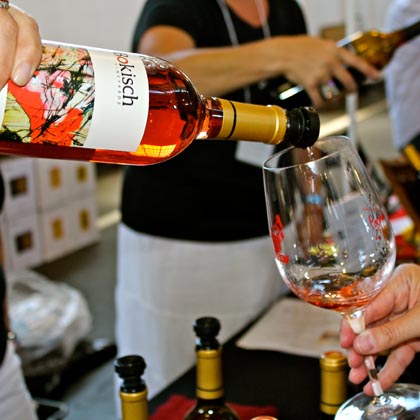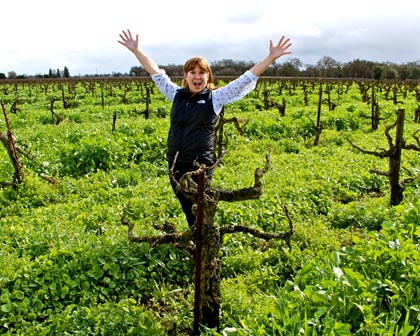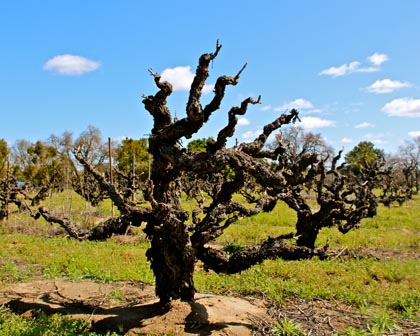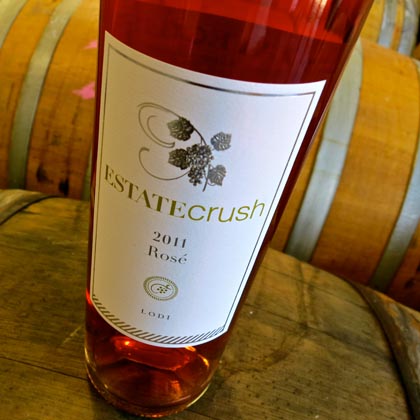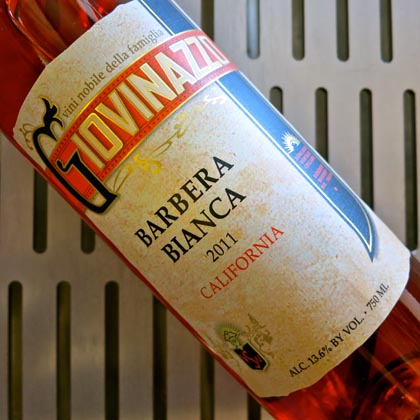Letters from Lodi
An insightful and objective look at viticulture and winemaking from the Lodi
Appellation and the growers and vintners behind these crafts. Told from the
perspective of multi-award winning wine journalist, Randy Caparoso.
Round-up of Lodi’s finest dry rosés
Summer sipping in Lodi...
Summer is heating up with a vengeance; and this year the wines that seem to be on everyone’s lips are dry rosés. And a good rosé, to paraphrase the bard, by any other name may smell as sweet, but are certainly not all the same.
To begin with, rosé wines come in many shades of color, from transparent orange/bricks to extremely bright coral or flamingo-like colors. Yet all are classified as rosé wines because they are made from black skinned grapes that normally produce red wines: most commonly, grapes like Grenache, Tempranillo, Carignane, Sangiovese, Pinot Noir, and Zinfandel (although those pink wines that first became so popular in the eighties – sold as White Zinfandel – were also commonly called “blush” wines).
At what point in a winery are black skinned grapes turned into rosés rather than red wines? From the moment they get there. Rosés are made in primarily two ways; re
1. Through skin contact: that is, soon after black skinned grapes are gently crushed; and the skins, where all the pigmentation comes from (the pulp of red wine grapes are generally colorless), are allowed to sit in contact with the juice (or must) for periods lasting anywhere from a few minutes to up to three days. After that, the skins are removed, and the wine is fermented like you normally would white wines (usually in temperature controlled stainless steel tanks).
2. Through a process called saignée (pronounced, son-yay), the French word for “bleeding”: after the black skinned grapes are crushed and held in a vat, a percentage of the juice (retaining some color from brief contact with skins) is almost immediately drawn off and then fermented separately to make a pink tinged wine. This method is favored by vintners whose primary aim is to make a more intense red wine (the part going into red wines, presumably made more concentrated by removal the partial bleeding of juice). When derived from saignée, pink wines are basically a byproduct of a style of red wine production.
With its huge yearly crop of Zinfandel (some 40% of the California crush each year), Lodi has always been a traditional source of pink colored, soft, fruity, and perceptively sweet, White Zinfandel. But aside from big production wineries like Woodbridge by Robert Mondavi, virtually no winery in Lodi actually bottles a White Zinfandel, as surprising as that might be.
Instead, many of Lodi’s specialty wineries have been producing pink wines in the classic European style: as completely dry rosé wines. Wines that make you think of salade Niçoise or lying bare on a beach in Monte Carlo; or else one of those endless, sun drenched Spanish afternoons when everyone is either lying in bed or nibbling on queso, Jamón or entremeses (or so goes the dream).
Phoenix winemaker Jillian Johnson in Bechthold Vineyard
A perfect example of this, crafted in the saignée style, is the 2011 Phoenix Ranch Bechthold Vineyard Lodi Cinsault Rosé ($18) – sourced from Cinsault grapes coming off the historic Bechthold Vineyard, the oldest continuously farmed vineyard in Lodi today. Like a classic Provençal inspired rosé, the Phoenix is a shimmering pale pink color, and as dry as summer; yet its palate tingling berry flavors caress the palate like sheer silk, waving in a breeze. This is an ultimate rosé drinker’s rosé – as much because of its extreme rarity (only 85 cases produced) and provenance (from 126 year old, own rooted vines!), as the simple fact that it is also as fine and refreshing as any rosé in the world. Available through phoenixvineyards.com or at Estate Crush in Downtown Lodi (at Lockeford and Sacramento).
Perhaps the most arresting Lodi grown example of a wine grown, crushed and fermented completely to produce pink wine is the 2011 Bokisch Terra Alta Vineyard Rosado ($16); which, despite the Spanish spelling for rosé, is actually made mostly from an Italian grape, Barbera (55%), with a balance of Garnacha (the Bokischs grow an authentic Spanish clone of the Grenache grape).
The Bokisch rosado has an amazing nose of plump Bing cherry laced with lavendery, scrubby, herbes de Provence-like nuances that practically project Mediterranean summers; its fruitiness revved up by bright, natural fruit acidity, and a soft, lush, refreshing feel belying the wine’s dryness and 14% alcohol. Says winemaker/owner Markus Bokisch, “we’re absolutely loving what Barbera adds to the blend… it’s the Barbera that gives the wine its acidity and the lavender-like note, adding complexity to the candied strawberry fruitiness we get from the Garnacha.”
Jean Rauser's mighty ancient Carignane
Varietal blending is also what makes the 2011 McCay Cellars Lodi Rosé ($18) an outstanding wine, along with a couple more reasons. First, because 70% of it comes from Jean Rauser’s 109 year old stand of Carignane – majestic old giants, located along Bruella Rd. Secondly, because winemaker/owneMichael McCay puts as much or more effort into his rosé as he does with his highly acclaimed red wines: taking Rauser’s Carignane, along with some Grenache and Syrah, and gently squeezing the juice out from their skins, transferring them into small stainless steel “barrels” to hold in cold temperatures for about 35 days. Then the dormant musts are moved into room temperatures, where they begin to ferment – a slow process (at least another 30 days), since fermentation is pushed along 100% on the strength of the grapes’ own natural yeasts (without inoculation of stronger cultured yeasts).
The result of Mr. McCay’s meticulous methodology is a medium-pink wine teeming with strawberry fruitiness, penetrating deep into the palate despite the wine’s bone dryness. The wine is also prickly with natural acidity, with a light (12.49% alcohol) and refreshing feel: definitely a connoisseur’s pink wine, well worth the extra effort to find (available through mccaycellars.com).
Another exceptional Lodi grown rosé, crafted in the classic dry style, is the 2011 LangeTwins Family Lodi Sangiovese Rosé ($13): a deeper colored, crimson-pink wine grown in the Lange family’s estate vineyard, across the street from their winery on E. Jahant Rd. Winemaker David Akiyoshi describes its fragrance as “rose petals and strawberry,” although there are also berry infused tea and baked rhubarb-like notes in the nose. This is a fleshier, rather full flavored style of rosé – the mouth-filling sensations owing more to the textured fruit qualities indicative in the wine’s vivid color than to its alcohol (a relatively light 12.8%) – while zesty natural acidity adds to the brightness.
But when summer’s heat really begins to oppress, it is the lightest, breeziest styles of pink wines that seem to refresh the most. On those days, we strongly recommend the 2011 Cochon California Old Vine Rosé ($21): a pale, translucent style of pink wine made largely from Bechthold Vineyard grown Cinsault, emanating beautifully distinct yet lacy, lilting wildflower, strawberry, anise and watermelon perfumes; further emphasized by a crisp, edgy tartness and real sense of lightness (available through cochonwines.com).
For pure, gushy exuberance of summer ripened fruits, the brightly pink, bone dry 2011 Estate Crush Lodi Rosé ($17) is hard to beat with its lightly tart, red cherry, faintly guava-like perfumes, woven from a blend of Lodi grown Sangiovese (from Jonathan Wetmore’s Round Valley Ranches), Petite Sirah (grown by Ross Schmiedt), and Zinfandel (from Estate Crush partners Bob and Ali Colarossi’s Stellina Vineyard).
Finally, for aficionados of absolutely the driest and sturdiest of rosés, Estate Crush also offers the 2011 Giovinazzo California Barbera Bianca ($25): a medium-full, pale orange tinged pink wine made completely from this Italian grape; grown in Gregg Lewis’ vineyard in Lodi’s Clements Hills AVA. The Barbera Bianca’s nose is subtle and low key, while evincing scrubby, dried straw, pomegranate and rhubarb-like fragrances. A desert dry taste a accentuated by lemon/lime acidity, which only makes the palate salivate all the more for all the things we crave in summer: chilled raw oysters with Tabasco, chili specked cold shrimp, scallop seviche, clams in tarragon laced broths, Vietnamese rolls in peanut or dipping sauces, hibachi grilled salmon, pesto or garlicky pastas, anchovy and crunchy Parmigiano salads… need we say more?
Summer, where is thy sting!
